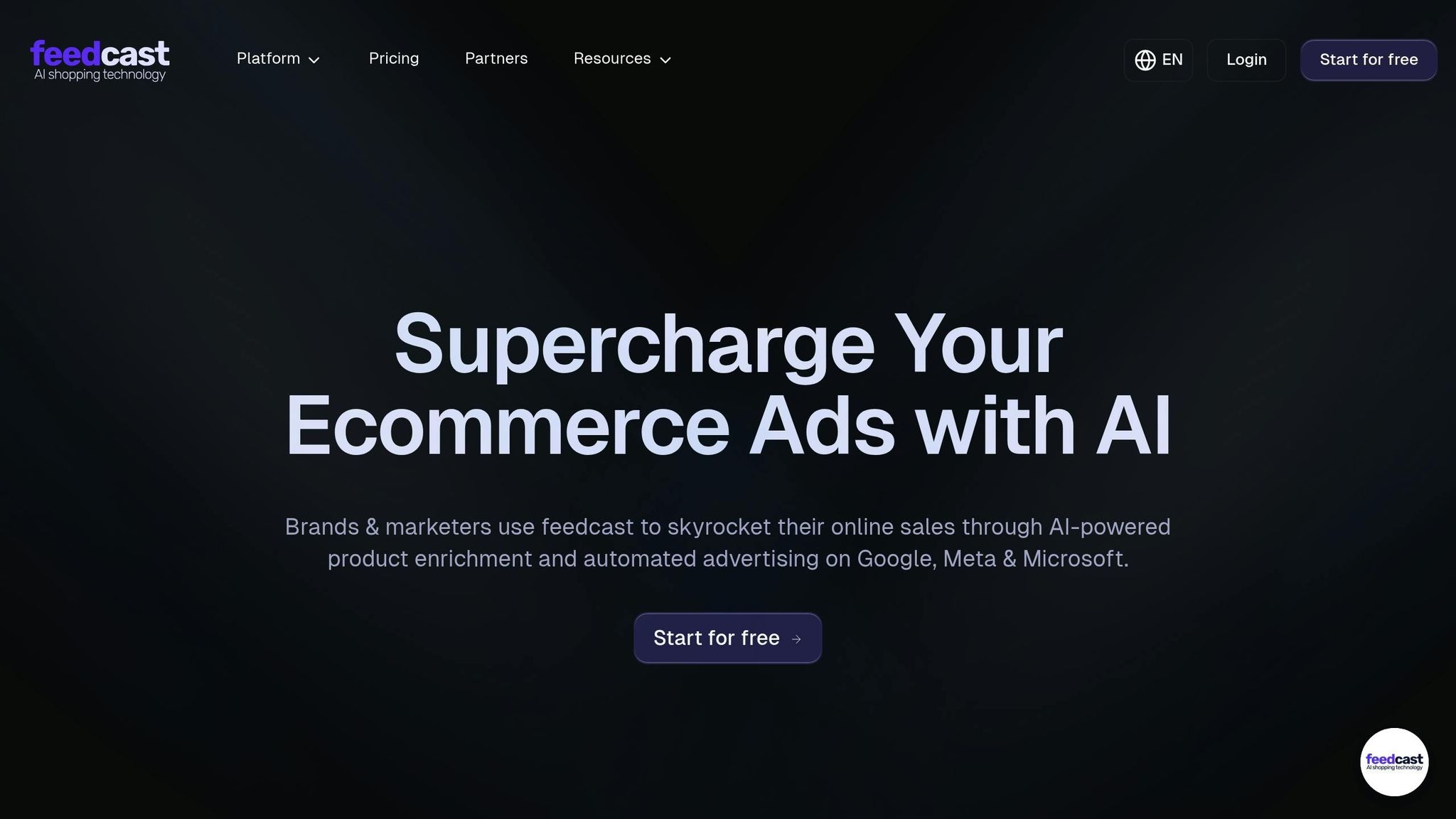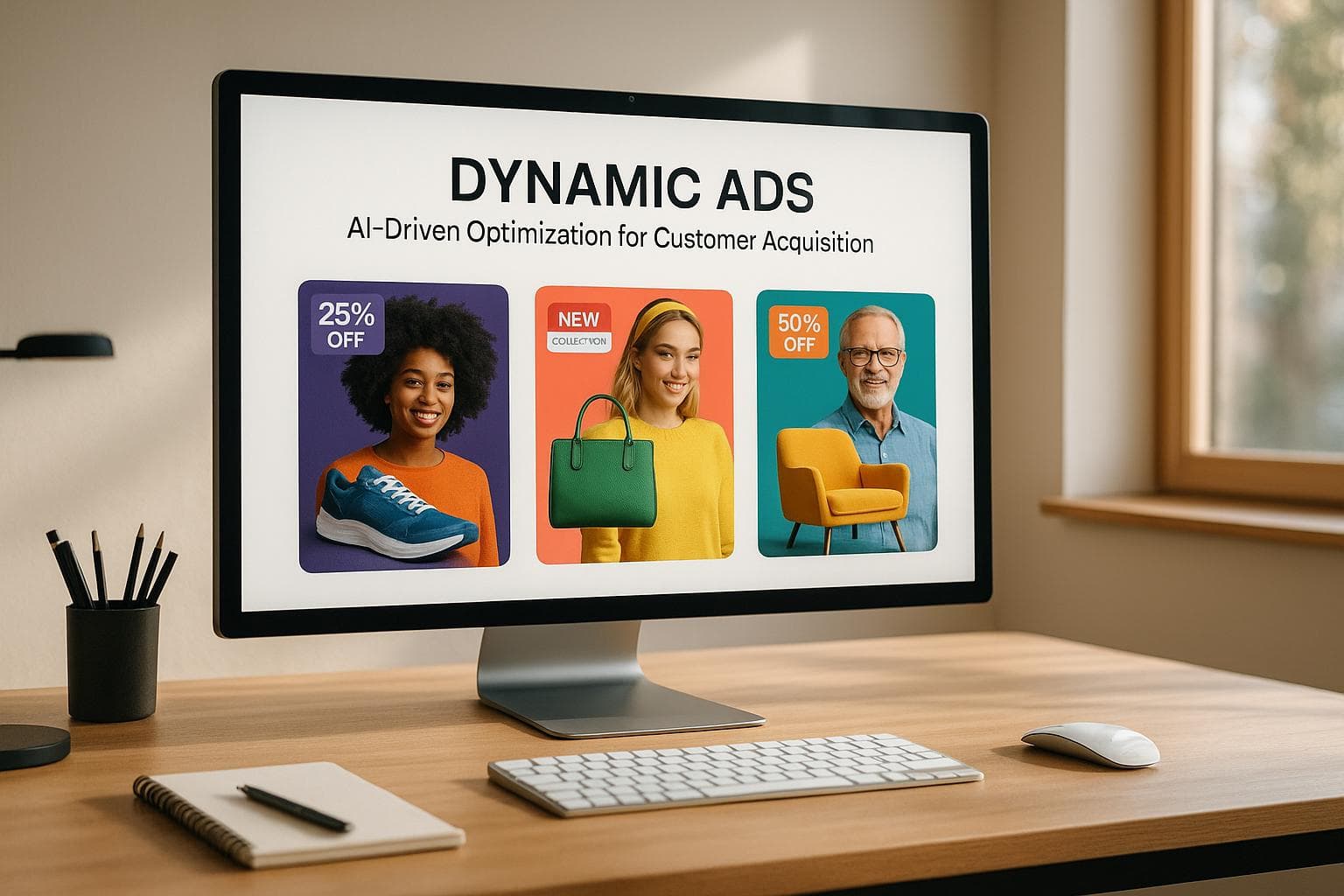Real-Time Personalization with AI: A Guide
Explore how AI-driven real-time personalization transforms e-commerce by enhancing customer experiences and boosting sales.
Real-time personalization in e-commerce uses AI to instantly tailor shopping experiences based on user behavior. Unlike static approaches, AI analyzes data like clicks, browsing patterns, and purchase history to predict preferences and deliver personalized content, recommendations, and even dynamic pricing. This strategy drives higher sales - boosting conversion rates by up to 20% and average order values by 10–15%. Tools like Feedcast.ai simplify personalization with features like product feed management, automated advertising, and multi-channel integration. By leveraging AI, businesses can meet customer expectations for relevant, engaging experiences while improving performance metrics like ROI and retention rates.
Key takeaways:
- What it is: Real-time personalization adapts content and recommendations instantly using AI.
- Why it matters: Increases sales (by 10–15%), ROI (5–8×), and customer satisfaction (84% prefer personalized experiences).
- How it works: AI analyzes real-time data (browsing, purchases) to predict and serve tailored offers.
- Tools: Platforms like Feedcast.ai centralize personalization efforts across channels, offering features like AI-driven ad creation and performance tracking.
- Results: Conversion rates can jump by 20%, with personalized recommendations driving 31% of e-commerce revenue.
AI personalization is no longer optional - it's a competitive advantage that delivers measurable results.
How Real-Time Behavioral Data Powers AI & LLMs | Snowplow for Agentic Systems & Personalization
AI Methods for Real-Time Personalization
AI is revolutionizing how e-commerce businesses engage with customers, offering personalized experiences that go far beyond basic tactics like adding a customer’s name to an email. By analyzing massive amounts of data in real time, AI can predict preferences and fine-tune interactions to meet individual needs. Below, we explore some of the key AI techniques driving this transformation.
AI Product Recommendation Systems
Modern product recommendation systems rely on machine learning algorithms to deliver tailored suggestions. These systems follow a four-step process:
- Data Collection: They gather insights from purchase history, browsing patterns, search behaviors, and real-time interactions.
- Data Formatting: The collected data is cleaned and organized for analysis.
- Pattern Recognition: Deep learning models identify trends and preferences.
- Personalized Delivery: Recommendations are shared across platforms like websites, apps, and emails.
Retail giants like Amazon and Sephora have mastered this approach, using it to boost customer satisfaction and drive sales. In fact, roughly 70% of e-commerce decision-makers believe AI will continue to refine their personalization strategies [3].
Dynamic Content Customization
AI takes personalization to the next level by customizing website elements - such as banners, landing pages, product displays, and even pricing - in real time. These algorithms predict the next logical step in a customer’s journey, ensuring users quickly find what they need without unnecessary searching.
One standout application is dynamic pricing, where AI adjusts prices based on factors like demand, competition, and user behavior. This approach not only maximizes revenue but also keeps businesses competitive. Marketing campaigns also benefit, as they can evolve and improve with each new piece of data, delivering increasingly precise personalization over time.
Predictive Analytics for Customer Targeting
Predictive analytics uses past behavior to forecast future actions, creating hyper-personalized experiences that go beyond traditional customer segmentation. For example, an AI-powered email might remind a shopper about items left in their cart while suggesting complementary products, making the path to purchase effortless.
This method also enhances ad targeting on platforms like Facebook and Google by analyzing search history, interests, and location data. The result? Ads that reach the right audience, improving return on ad spend. Predictive analytics can even tackle cart abandonment by sending tailored reminders, offering dynamic discounts, or initiating proactive follow-ups.
AI Chatbots and Virtual Assistants
AI chatbots provide instant, around-the-clock support, resolving customer inquiries and guiding them through their shopping journey. Powered by machine learning and natural language processing, these tools deliver accurate responses in real time.
Voice-enabled assistants like Alexa and Siri are also transforming how customers interact with brands, enabling conversational exchanges that build trust. Tools like Bloomreach Clarity make it easy for users to get answers, complete purchases, and receive personalized recommendations - all without navigating multiple pages. By addressing concerns promptly, these chatbots not only enhance user experiences but also drive higher conversion rates.
These AI-driven methods are reshaping e-commerce by creating intelligent, responsive shopping experiences tailored to individual needs. The result? Happier customers and stronger business performance.
Tools and Platforms for AI Personalization
Achieving success with real-time personalization hinges on selecting tools that effectively handle data, provide instant insights, and seamlessly integrate across multiple channels. The best platforms combine data analysis, dynamic content, predictive analytics, and cross-channel integration to create tailored user experiences.
When assessing these platforms, businesses should prioritize features like unified dashboards for managing personalization efforts across channels, AI-driven data enrichment tools, and real-time analytics to quickly adapt strategies. It's also critical to ensure strong data privacy measures and transparency when dealing with customer information. A centralized management system can help businesses streamline personalization efforts across websites, email campaigns, social media, and advertising, enabling consistent and cohesive customer interactions. Feedcast.ai is a prime example of such a solution.
Feedcast.ai: E-commerce Personalization Platform

Feedcast.ai has established itself as a standout platform that merges AI-driven personalization with practical e-commerce advertising, delivering measurable results for thousands of businesses.
At its core, Feedcast.ai focuses on AI-powered product feed management and automated advertising. The platform's algorithms enhance product data to improve visibility and deliver precise, persuasive messaging to potential customers.
One of Feedcast.ai's key strengths lies in its unified multi-channel approach. Businesses can connect all their advertising accounts - such as Google, Meta (Facebook and Instagram), and Microsoft Ads - into a single, user-friendly dashboard. This centralized system ensures consistent, personalized messaging across platforms while offering real-time performance analytics to fine-tune strategies and deliver immediate, tailored experiences.
The platform also excels in smart targeting, helping businesses attract new customers while re-engaging past buyers to support both acquisition and loyalty goals. AI-generated ad copy ensures that campaigns are customized to fit the audience of each channel, while automated campaign optimization continuously enhances performance using up-to-date data.
As a certified Google CSS partner, Feedcast.ai provides cost-saving benefits for Google Shopping campaigns, allowing businesses to allocate those savings toward further personalization efforts. The platform integrates smoothly with popular e-commerce systems like Shopify, WooCommerce, and Prestashop. It also supports various file formats - such as CSV, XML, and Google Sheets - making it easy to import product feeds.
Feedcast.ai offers flexible pricing plans to meet diverse business needs:
- Starter Plan (Free): Includes unlimited products, product validation, 5 AI credits, and access to a unified dashboard.
- Autopilot Plan ($99/month): Offers 150 AI credits, AI chat support, and management for one channel (additional channels for $25 each).
- Premium Plan ($249/month): Features unlimited channel management, 500 AI credits, and 24/7 support.
- Enterprise Options: Tailored for businesses with advanced needs.
With its robust features and flexible pricing, Feedcast.ai provides businesses with the tools they need to elevate their personalization strategies and drive meaningful engagement.
sbb-itb-0bd1697
How to Implement Real-Time Personalization
Implementing AI-driven real-time personalization effectively requires a thoughtful strategy that blends technical know-how with ethical data practices. To make it work, businesses need to focus on three main areas: building a strong data foundation, adhering to legal requirements, and constantly improving performance through testing. These steps form the backbone of the dynamic, AI-powered interactions mentioned earlier.
Data Collection and Management
The key to successful personalization is having unified data from all customer interactions. Businesses should gather and integrate three main types of data:
- Behavioral data: This includes browsing habits, clicks, and time spent on various pages.
- Transactional data: Think purchase history, abandoned carts, and return patterns.
- Demographic data: Information like age, location, and device preferences.
Clean, accurate data is crucial. Regularly validating and deduplicating data ensures that AI models work with reliable information. Using AI-enhanced data enrichment helps create more complete customer profiles, improving the overall effectiveness of personalization.
Handling multiple systems can get complicated, so it’s important to use platforms that integrate smoothly with e-commerce systems. This approach eliminates data silos, which can disrupt personalization efforts.
For real-time personalization, the ability to process data immediately is non-negotiable. Systems need to capture and analyze customer interactions as they happen, allowing for instant updates to product recommendations, content, and advertising. To achieve this, businesses need infrastructure that can handle large data volumes without delays.
Privacy and Legal Compliance in the US
When implementing personalization, it’s critical to follow US privacy laws. For instance, the California Consumer Privacy Act (CCPA) requires businesses to get explicit consent for data collection, maintain transparent privacy policies, and allow users to access or delete their personal data. Companies operating internationally also need to consider GDPR compliance for customers in Europe.
Being transparent about data usage is essential for building trust. Clear communication about how data is used for personalized recommendations, exclusive deals, or better shopping experiences helps customers see the value in sharing their information. Privacy policies should explain this in straightforward language.
Adopting privacy-by-design principles means embedding data protection into personalization systems from the start. This includes practices like collecting only necessary data, anonymizing it when possible, and securely storing it. Businesses should also offer easy ways for customers to opt out and promptly honor privacy-related requests.
Consent management systems play a critical role here. These systems track user preferences across channels, allowing customers to control how their data is used. For example, someone might agree to personalized product recommendations but decline targeted advertising. This kind of flexibility respects customer choices while still supporting personalization efforts.
Once privacy measures are in place, the focus can shift to refining and optimizing personalization strategies.
Testing and Performance Optimization
Continuous testing is vital for improving personalization efforts. A/B testing and multivariate testing can help fine-tune personalization elements in real time.
With AI-driven analytics, businesses can take optimization a step further. Systems can automatically adjust product recommendations, tweak ad content, and refine targeting based on live engagement data. This kind of dynamic adjustment ensures that personalization stays aligned with evolving customer preferences and market trends.
Tracking performance requires monitoring multiple metrics. Conversion rates, average order values, customer lifetime value, and engagement metrics all provide insights into how well personalization is working. Start by establishing baseline metrics, then track improvements over time to measure success.
Iterative improvement is key. Regularly analyzing customer feedback, engagement trends, and conversion data helps identify areas for enhancement. This might mean updating recommendation algorithms, incorporating new data sources, or fine-tuning targeting to better meet customer needs.
Collaboration across teams is another critical factor. Marketing, IT, and customer service teams each bring unique insights into customer behavior, technical capabilities, and operational needs. Regular communication ensures everyone is aligned and helps identify ways to improve personalization across all customer touchpoints.
Measuring Personalization Performance
Once you've implemented your personalization strategy, the next step is to evaluate how well it's working. Measuring its impact involves tracking key metrics that highlight both successes and areas for improvement.
Performance Metrics to Track
Certain metrics provide a clear view of how personalization affects your business. For example, the conversion rate - the percentage of visitors who complete specific actions like purchases or sign-ups - shows how effectively your personalized efforts drive customer behavior.
Another critical metric is average order value (AOV), which indicates whether personalized recommendations are encouraging customers to spend more per transaction. Similarly, the customer retention rate measures loyalty by tracking repeat purchases over time. To evaluate the overall financial impact, return on investment (ROI) helps quantify how much value your personalization efforts are generating compared to the costs.
Performance data shows that personalization can lead to conversion rate increases of up to 15% and retention gains of 5–10%. Amazon, for instance, attributes up to 35% of its revenue to its recommendation engine, which suggests products based on user behavior[2].
In addition to these core metrics, you can track click-through rates on personalized content, time spent on site, and cart abandonment rates. These provide deeper insights into customer engagement and help pinpoint areas where your strategy might need adjustments. Using integrated dashboards to monitor these metrics makes it easier to analyze trends and refine your approach.
Analytics Dashboards for Performance Tracking
To track performance effectively, analytics dashboards are invaluable. Tools like Feedcast.ai's dashboard consolidate key metrics into a single interface, allowing you to monitor and adjust your strategy in real time.
Feedcast.ai’s dashboard tracks data across advertising channels, displaying metrics like conversion rates, AOV, and ROI for each campaign. This unified view lets you compare performance across channels and identify the most effective strategies. Custom reporting features also make it possible to segment data by audience, product category, or campaign type, providing a clearer picture of what resonates with different customer groups.
For example, breaking down performance by device - such as comparing mobile versus desktop conversion rates - can reveal which parts of your strategy are most effective. These insights enable you to make quick, informed adjustments to optimize your personalization efforts.
AI Personalization Methods Comparison
Different AI personalization methods come with unique benefits and challenges, especially when it comes to measuring performance. Choosing the right approach depends on your business goals and how you plan to track results.
| Method | Advantages | Disadvantages |
|---|---|---|
| Product Recommendation Systems | Directly impacts sales and AOV; easy to track | Needs large datasets; risk of overfitting |
| Dynamic Content Customization | Boosts engagement; works across channels | Harder to link to direct sales |
| Predictive Analytics | Anticipates customer needs; aids retention | Requires advanced expertise; potential privacy concerns |
| AI Chatbots/Virtual Assistants | Improves support; gathers customer feedback | Tough to measure direct sales impact; complex setup |
Product recommendation systems are often the easiest to measure since you can directly track which suggested items customers purchase, making ROI calculations straightforward.
Dynamic content customization enhances engagement metrics like time spent on site or page views. However, connecting these metrics to actual sales often requires sophisticated attribution models. Despite this, it plays a key role in building stronger customer relationships.
Predictive analytics helps improve long-term metrics like customer lifetime value and retention rates, though the results often take time to materialize.
Finally, AI chatbots and virtual assistants provide valuable customer feedback and improve satisfaction, even if their direct impact on sales is harder to quantify.
Regularly reviewing these methods and their associated metrics ensures you’re using the best strategies for your business. This approach helps you understand how each method contributes to your overall personalization efforts, keeping your strategy aligned with your goals.
Conclusion: AI-Powered Real-Time Personalization
Real-time personalization has become a game-changer for driving engagement and boosting ROI in e-commerce. With AI at the helm, businesses can analyze massive amounts of customer data instantly, delivering tailored experiences that go far beyond traditional segmentation methods.
The impact is clear. AI-driven personalization can increase conversion rates by as much as 15% and raise average order values by 20%. Plus, 80% of consumers are more inclined to buy from brands that offer personalized experiences[1][2].
What’s more, AI doesn’t just react to customer behavior - it predicts it. By anticipating preferences and serving up the right products at the right time, businesses are seeing real results. Personalized product recommendations, for example, now account for up to 31% of e-commerce revenue on leading platforms[1].
The tools and strategies discussed earlier are crucial for success. Platforms like Feedcast.ai make advanced personalization accessible by centralizing feed management, automating ad creation, and unifying analytics. Over 3,000 e-commerce brands are already using these tools to elevate their performance.
Getting started with AI-powered personalization is simpler than ever. Businesses can explore the benefits with a free tier, and features like AI-driven product enrichment and automated campaign management can deliver immediate gains in visibility and targeting. For instance, saving 20% on Google Shopping campaigns can quickly justify the investment.
The time to act is now. With 70% of e-commerce decision-makers confident that AI will enhance personalization efforts[3], the competitive edge belongs to those who embrace the technology early. The tools are ready, the results are proven, and waiting only increases the risk of falling behind competitors already meeting customer expectations for personalized shopping experiences.
This blend of data, AI, and smart tools is shaping the future of e-commerce. Feedcast.ai offers the means to simplify customer engagement and fuel growth, turning casual browsers into loyal buyers. The future of e-commerce is personal, and it’s happening right now.
FAQs
What makes real-time personalization with AI different from traditional methods in e-commerce?
Real-time personalization powered by AI takes customer engagement to a whole new level by responding instantly to customer actions. Unlike older methods that depend on set rules or historical trends, this approach uses advanced algorithms to analyze interactions as they happen, creating highly tailored experiences on the spot.
For instance, AI can suggest products based on what a shopper is browsing right now, combined with their preferences and purchase history. This on-the-fly adaptability not only makes the experience more relevant but also helps e-commerce businesses improve customer satisfaction, boost conversions, and build long-term loyalty.
What are the main advantages of using AI-powered product recommendation systems in e-commerce?
AI-driven product recommendation systems bring a range of benefits to e-commerce businesses. One standout advantage is their ability to create personalized shopping experiences. By analyzing a customer’s behavior, preferences, and purchase history, these systems suggest products tailored to individual tastes. This not only enhances customer satisfaction but can also lead to higher sales.
Another key feature is the ability to deliver real-time recommendations. Whether customers are browsing your site, viewing ads, or reading emails, AI ensures they’re presented with the most relevant products at the perfect moment. This approach boosts engagement and encourages repeat purchases.
On top of that, AI streamlines operations by offering greater efficiency. Automated product suggestions eliminate the need for manual effort, saving businesses time while improving accuracy. This allows teams to focus on broader strategies to drive growth.
How can businesses use AI for real-time personalization while staying compliant with privacy laws?
To comply with privacy laws while using AI for real-time personalization, businesses need to focus on transparency and securing user consent. Make it clear how customer data is being collected, stored, and used. It's also essential to give users the option to opt in or out of data collection, ensuring they remain in control of their information.
Protecting sensitive data is equally important. Implement strong security measures to safeguard user information. Stay up-to-date with regulations like the GDPR or CCPA, depending on where your audience is located, and consult with legal professionals to ensure your practices meet current legal standards. Regular audits of your AI systems can help confirm that data is handled ethically and in line with the law.
Geoffrey G.










